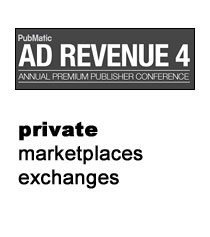 Today, PubMatic produced its annual Ad Revenue Conference in New York City focused on the sell-side of the ad ecosystem. In a panel bringing together thought leaders who’ve “been busy” in the private marketplace or exchange space (whichever you prefer), Upstream Group’s Doug Weaver ably guided discussion about who’s buying and selling privately in audience-based media – and why.
Today, PubMatic produced its annual Ad Revenue Conference in New York City focused on the sell-side of the ad ecosystem. In a panel bringing together thought leaders who’ve “been busy” in the private marketplace or exchange space (whichever you prefer), Upstream Group’s Doug Weaver ably guided discussion about who’s buying and selling privately in audience-based media – and why.
Participants included voices from the buy and the sell-side:
- Teri Gallo, VP – Marketplace Development, Cadreon
- Martin Gilliard, VP – Platform Services, The MIG – WPP Group
- Mario Diez, CEO, quadrantONE
- Mark Westlake, Chief Revenue Officer, TechMediaNetwork
Overall the tone of the panel was that private marketplaces – or exchanges or ad slots or whatever you want to call them – are an exciting development where the buy-side looks forward to more transparency and first look access on behalf of clients. On the sell-side, publishers are intrigued by better control (overcoming channel conflict, for example) then it had with its ad network relationships, higher CPMs and a way to tap the alluring ad spend pouring forth from agency trading desks.
Spinning in the middle of all of this is real-time bidding (RTB) and the inventory that it can address today with better efficiency then previous solutions.
One important theme from today’s panel: it’s still early days for private whatevers.
Among many interesting insights from the panel, Weaver prodded each panelist on good and bad surprises – real examples – they’ve experienced about private marketplaces.
TechMediaNetwork’s Mark Westlake said a downside has been hearing a potential buyer inadvertently raise the channel conflict issue and say, “Oh, you’re on the exchange, so we can’t buy you directly. We’re going to buy you through the exchange.”
Teri Gallo of Mediabrands’ Cadreon offered her buy-side, agency trading desk perspective about the good and the bad:
“The Good surprise is when you get it right, this really works and everybody is successful. We’ve had some cases where you never really thought that BMW belongs in this place. When it happens and you collaborate, it works.”
Meaning, new, successful placement can be realized by inventory discovered in the private marketplace.
And “the bad?” Gallo added:
“The bad piece, which is something we’re all working on together, is operationally getting these exchanges, private exchanges wired -it’s still cumbersome. Not nearly as cumbersome as some of the other old world digital trafficking activities that we all participated in. Just making sure that everyone knows who to communicate with, how to communicate and get set up and running is probably in the bad category.”
Another big theme is how important the human is here. Relationships! Sure, it’s about programmatic or automated buying to a degree, but strong relationships between agencies and their publisher partners means only good things for both as each partner informs the other about what works and what doesn’t.
quadrantONE CEO Mario Diez said his company saw great lift year-over-year from private exchanges/marketplaces and a better view into what’s working and what doesn’t. On the negative side, Diez emphasized the importance of relationships:
“We have to build relationships with technology. So not that it was a negative, it was just, ‘Slow down. Plan life’s little surprises a little bit better and make the plan about your marriage.'”
Beware the allure of the tech panacea, publishers … at least, at first.
Finally, the MIG’s Martin Gilliard provided his buy-side thoughts succinctly saying that the tech works, but a downside remains: “It’s got a perception that this is about price – and it’s not really about price. Bad perception.”
– and that perception exists between the agency and the publisher as well as the agency and its marketer client. It’s not all about price, but it is about performance -and, even brand can be performance-based.
“Gulp” goes the big brand marketer.
By John Ebbert









